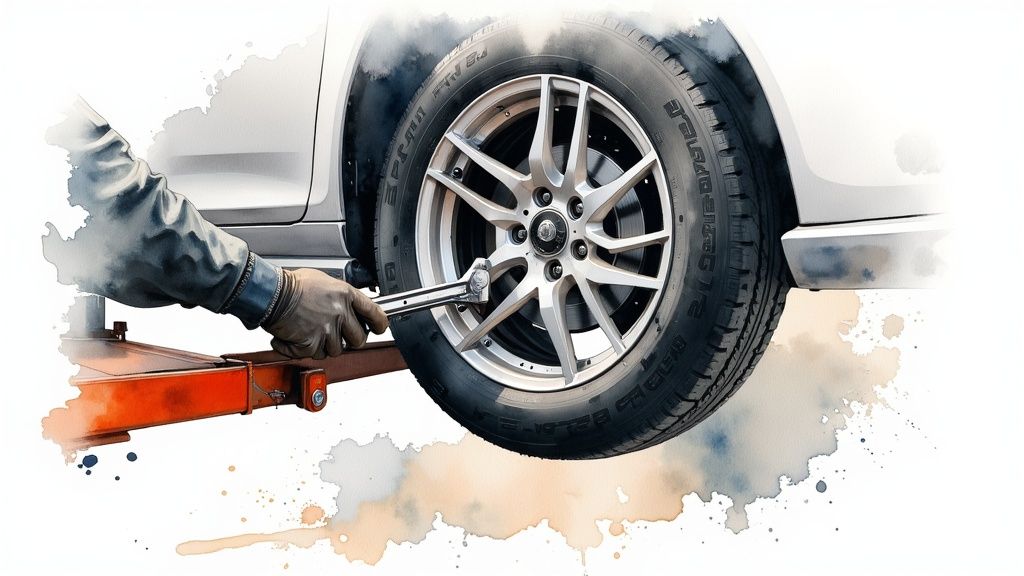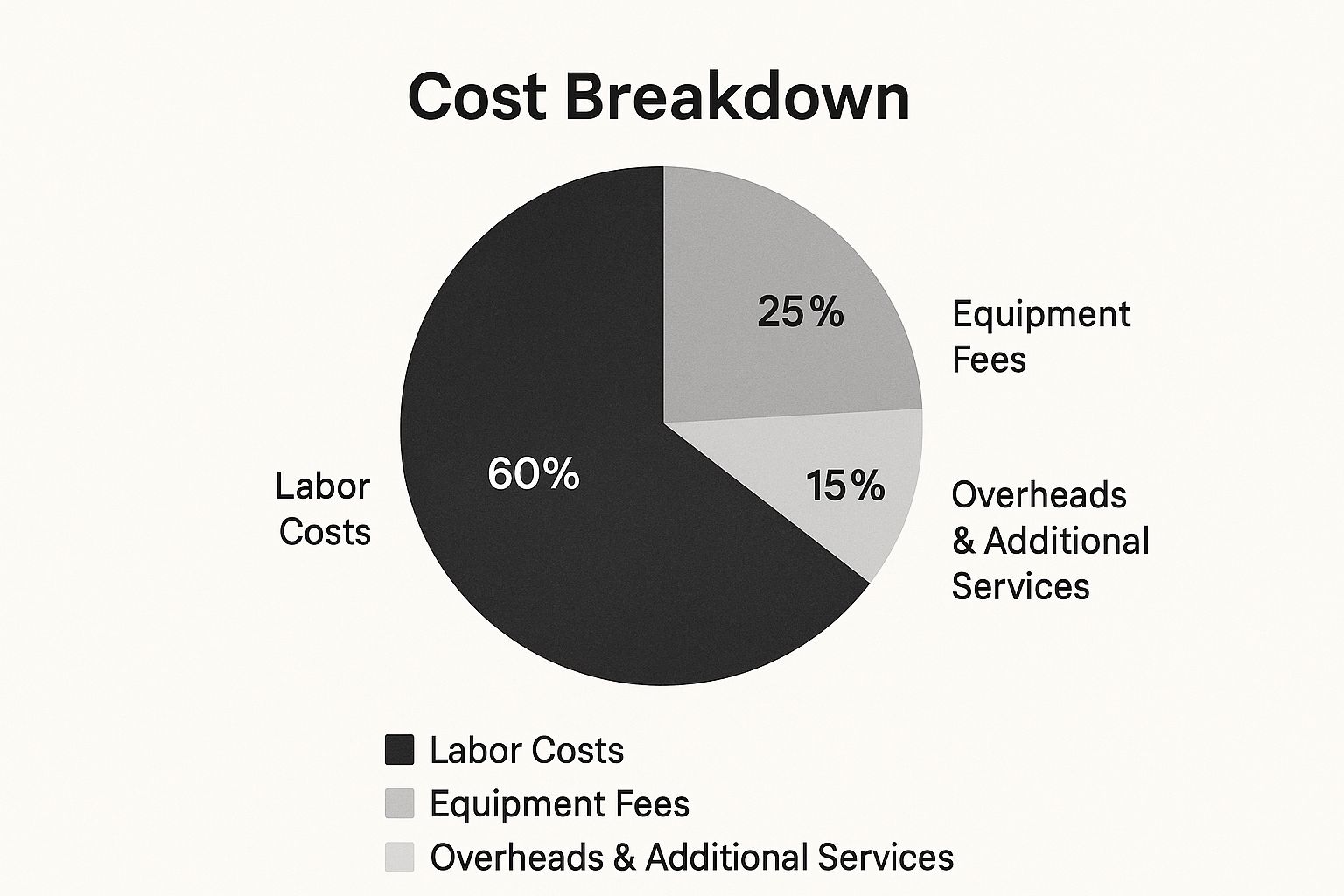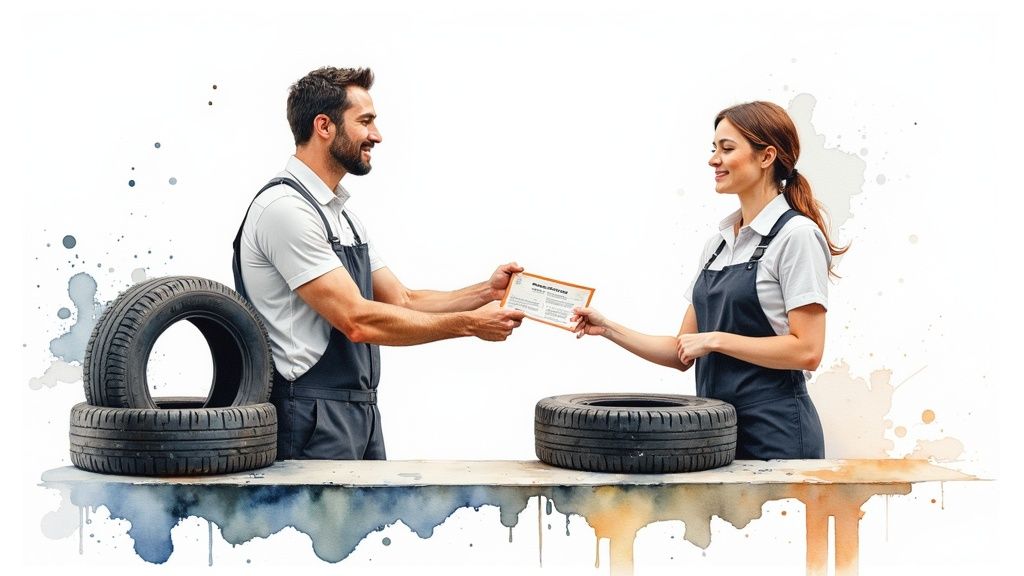
Kwik Kar Service Coupon
Get upto $20 OFF on all services.

Tire rotation is a crucial part of car maintenance. It promotes even wear on your tires, which helps them last longer and perform better. But the price of this service can differ quite a bit. So, what exactly influences tire rotation pricing? Knowing the key factors can help you make smart decisions and possibly save some money.
The type of vehicle you drive is a major factor in the cost. Luxury cars and high-performance vehicles often need specialized equipment and a higher level of expertise, resulting in higher prices. Think about sports cars with low-profile tires or heavy-duty trucks with oversized tires – these require more intricate handling.
Your tire specifications also play a role. Larger, heavier tires, or those with unusual tread patterns, can make the rotation process more complex, and therefore more expensive.
Where you live also affects the price. Areas with higher labor costs generally see higher prices for tire rotation services. The same service might cost more in a big city compared to a small town. The specific service provider matters, too. Dealerships, specialty tire shops, and quick-service chains often have different pricing structures. You might be interested in: Our sitemap for more information.
Many shops offer tire balancing along with rotation. This added service, while beneficial, increases the total cost. Market conditions, like the cost of materials and the overall economy, can also influence pricing.
The average tire rotation cost in major U.S. markets is between $60 and $72. Adding balancing usually bumps the price up to between $112 and $132. This range depends on things like vehicle type, tire specifications, and local labor costs. Luxury or high-performance vehicles can cost even more because of the specialized equipment and expertise required. Specialty tires might also need different handling, affecting the final price.
Tire rotation is key for extending tire life and improving vehicle handling and safety. This makes it a recurring cost for vehicle owners worldwide. You can explore this topic further here. Understanding these factors helps you decide if the price you're quoted is fair for your situation.
Not all tire rotation services are the same. Cost is a big factor, but knowing what you get for your money is key. This means looking past the price and considering the overall value offered. This section will guide you through the different options, helping you find the best deal.
Understanding tire rotation costs means breaking down the parts that make up the final price. It's not just the service itself, but also things like labor, equipment, and possible add-ons. The infographic below shows a typical cost breakdown for a tire rotation.

As you can see, labor is usually the biggest expense, followed by equipment fees, then overheads and extra services. This shows why it’s important to look beyond the initial price. Besides cost, practical tips are also essential. Learn more with these helpful tire rotation tips.
There are several types of service providers to choose from, each with its own pricing structure. Dealerships often have higher prices, but they might include perks like multi-point inspections or warranty coverage. Specialty tire shops usually fall in the mid-range and offer expert knowledge. Quick-service chains often advertise the lowest prices, but they might try to sell you extra services. Finally, independent mechanics offer personalized service at competitive prices, but their skill and equipment can differ. To help you compare, we've put together a table summarizing average costs.
To help you compare pricing across these different providers, the following table summarizes average costs. It also highlights the average time for the service and potential additional services that may be available.
Average Tire Rotation Costs by Provider Type
| Provider Type | Basic Rotation Cost | With Balancing | Average Time | Additional Services Available |
|---|---|---|---|---|
| Dealerships | $40 – $80 | $60 – $100 | 45-60 minutes | Multi-point inspections, warranty coverage |
| Specialty Tire Shops | $30 – $60 | $50 – $80 | 30-45 minutes | Tire repairs, wheel alignment |
| Quick-Service Chains | $20 – $40 | $40 – $60 | 20-30 minutes | Oil changes, other fluid top-offs |
| Independent Mechanics | $25 – $50 | $45 – $70 | 30-60 minutes | Brake inspections, other general repairs |
As the table shows, quick-service chains generally offer the lowest base price, while dealerships tend to be the most expensive. However, remember to consider the additional services offered and the overall value.
Some providers include tire balancing in their basic rotation cost, while others charge extra. Make sure you know what’s included to avoid surprises. Don’t just look at the price tag. Think about expertise, warranty protection, and the time it takes for the service.
Plan your tire rotation strategically to save money. Many providers offer seasonal discounts or promotions. Combining your tire rotation with other services, like an oil change, can also lower the total cost. Examine bundle offers carefully to make sure they're worthwhile for your vehicle and driving habits. By understanding these details, you can choose the best tire rotation service for your car and budget.

Rotating your tires yourself might seem like a simple way to save money. But a quick cost comparison between DIY and professional service doesn't give you the full picture. There are hidden costs and potential risks to think about. This section provides a detailed cost analysis to help you make a well-informed decision.
For a DIY tire rotation, you'll need certain equipment. This includes a jack, jack stands, a lug wrench, and possibly a torque wrench Tekton for accurate tightening. Buying these tools can be a substantial initial cost, from $50 to $200 or more, depending on their quality. Even if you consider this a one-time purchase, tools can break or wear down and need replacing eventually.
DIY tire rotation requires time. Even for experienced people, it can take 1-2 hours. Think about what your time is worth. Could you spend those hours doing something more productive or enjoyable? This hidden cost is often forgotten.
Incorrectly performed maintenance could void some vehicle warranties. For instance, improperly tightened lug nuts can damage the wheel or even cause it to detach. This might invalidate your warranty coverage. Professional tire rotation guarantees the job is done right, safeguarding your vehicle's warranty.
DIY tire rotation has its risks. Using the wrong rotation patterns, over-tightening, or under-tightening lug nuts can cause uneven tire wear, vibrations, and even create hazardous driving conditions. These mistakes can lead to expensive repairs later, wiping out any initial savings.
Some vehicles are better suited to DIY maintenance than others. Cars with complex suspension systems or specific tire setups may need special tools and knowledge, which most DIYers don't have. For these vehicles, professional rotation is the safer and possibly more affordable option in the long run.
A hybrid approach can be a good compromise. You could remove and reinstall the tires yourself, then take them to a shop for balancing. This saves some labor costs while still utilizing professional skills for more technical aspects.
By considering these factors, including equipment costs, the value of your time, potential risks, and your vehicle's specific needs, you can determine the true cost of a tire rotation and choose the best option for you. Think about the long-term expenses and benefits, not just the initial price.
The price of a tire rotation isn't set in stone. It's influenced by broader trends in the automotive world. Understanding these trends provides valuable context for price fluctuations and helps you make smarter choices about car maintenance.
A major factor affecting tire rotation cost is the growth of the global tire market. Valued at about $142.7 billion, it's expected to surpass $211 billion by 2032. This growth, fueled by increased vehicle production and tire technology advancements, has a ripple effect on maintenance. Newer tires often demand specialized care, impacting rotation services. This market also supports a significant workforce, with over 800,000 U.S. tire industry jobs. You can find more statistics here. This highlights the economic importance of tire services, including rotation.
The auto industry, like many sectors, is grappling with a labor shortage. This technician scarcity directly impacts labor costs, a major part of tire rotation pricing. Fewer technicians also lead to longer wait times and potentially higher prices from increased demand. The shortage also reflects the growing complexity of modern cars and the specialized skills needed to service them, potentially affecting rotation costs, especially for newer or high-performance models.
New technologies are changing tire service. Modern tire designs, like run-flat tires, might require different rotation procedures and equipment. Advancements in service equipment can improve efficiency but also increase upfront costs for providers, potentially affecting consumer prices. So, while technology can boost tire life and performance, it can also contribute to higher short-term service costs. Read also: How to master….
Global supply chain issues have significantly affected the auto industry. These disruptions, coupled with inflation, impact material costs for tire production. Consequently, replacement tire prices rise, indirectly influencing related services like rotation. Providers might adjust pricing to offset these rising expenses, increasing consumer costs. This link between material costs and service prices emphasizes the need to consider broader economic factors when evaluating tire rotation expenses.
That familiar screech of tires during a rotation might soon be accompanied by the groan of your wallet. The cost of tire rotation, like many automotive services, is on the rise, and the reason isn't just inflation. It's connected to a complex web of factors, including a major crisis in raw materials.
Tires aren't simply made of rubber. They're a complex blend of materials, each crucial for performance and durability. Natural rubber, synthetic polymers, and steel cord are key components, and their prices have been anything but stable. Fluctuations in these markets directly impact tire manufacturing costs, which then affect the price of services like tire rotation.
For instance, natural rubber, vital for tire production, has seen significant price swings. This instability, often caused by things like weather impacting harvests and growing global demand, makes pricing unpredictable for manufacturers. Furthermore, synthetic polymers, essential for tire durability and performance, rely heavily on petroleum, a commodity with its own price fluctuations.
These rising material costs create a ripple effect across the tire industry. Tire manufacturers absorb some of the increased expenses, but some inevitably get passed on to consumers, not only in the price of new tires but also services like rotations. Tire prices have been increasing globally due to several economic and supply-chain factors, also impacting tire rotation costs. From April 2020 to April 2021, natural rubber prices surged by almost 80% due to shortages and increased demand.
Service providers are in a tough spot. They have to balance rising operating costs with staying competitive. This often leads to price adjustments for services, including tire rotations. Some providers might absorb some of the cost increases, while others pass on a greater percentage to the consumer.
Seasonal demand also affects tire rotation costs. Peak seasons, like spring and fall when drivers switch between summer and winter tires, can see higher demand and potentially higher prices. Understanding these seasonal patterns can help you time your tire rotations strategically and potentially save money. By understanding the interplay of raw material prices, manufacturer costs, and service provider adjustments, you gain insights into the cost of tire rotation. This knowledge empowers you to assess price increases, recognize fair pricing, and make smart decisions about your vehicle maintenance.

While the initial cost of tire rotation might seem like just another expense, it's a savvy investment. It offers significant financial returns over the long haul. This simple maintenance practice can dramatically extend the life of your tires and boost your vehicle's performance. Ultimately, this leads to substantial savings.
Regular tire rotation is key for even tire wear. Tires wear differently based on their location on your car. Front tires, especially on front-wheel-drive vehicles, wear down faster because of steering and braking.
Rotating your tires distributes wear evenly. This simple act can add thousands of miles to the life of your tires. This delays the need for replacements, saving you money. Rotating every 5,000-7,500 miles can increase tire life by as much as 20%.
Properly rotated tires also improve fuel efficiency. Uneven wear creates more rolling resistance. This forces your engine to work harder and use more gas. Maintaining even tread depth minimizes rolling resistance, improving fuel economy.
While the improvement per fill-up might seem small, it adds up over time, especially for those who drive a lot. Even tire wear also improves handling and safety. You might also be interested in this: How to master…
Tire rotation is more than just tires; it's a chance for preventative maintenance. During a rotation, technicians inspect your tires for potential problems. This might include alignment issues, worn suspension components, or brake wear.
Catching these problems early can prevent bigger, more expensive repairs later. A simple alignment adjustment, often detected during rotation, can prevent premature wear and extend tire lifespan.
Neglecting tire rotations can lead to a series of expenses. Premature tire wear, lower fuel efficiency, and a higher risk of mechanical problems contribute to higher maintenance costs.
The following table illustrates the long-term cost benefits of regular tire rotation:
To understand the financial impact of regular tire rotations, let's look at a cost-benefit analysis:
| Maintenance Scenario | Initial Cost | Annual Cost | Tire Lifespan | Replacement Frequency | 5-Year Total Cost |
|---|---|---|---|---|---|
| No Rotation | $0 | $0 | 30,000 miles | Every 2.5 years | $1200 (assuming $600 per set) |
| Regular Rotation | $25 per rotation | $100 (4 rotations per year) | 40,000 miles | Every 3.33 years | $1100 (assuming $600 per set + rotation costs) |
This table demonstrates how regular rotations, despite the added cost of the service itself, contribute to longer tire lifespan and ultimately lower overall costs in the long run. Even small increases in tire lifespan can lead to significant savings over several years.
Investing in regular tire rotations isn't just about extending tire life. It's a smart financial move that saves you money on replacements, fuel, and potential repairs. This makes tire rotation a surprisingly effective way to boost your vehicle's performance and protect your finances over time.
Smart vehicle owners understand that maintaining their tires doesn't have to break the bank. There are numerous ways to reduce the cost of tire rotation without compromising on quality. Let's delve into some insider strategies that can help you save.
Many national chains and local tire shops offer loyalty programs that include discounts on tire rotations. These programs can result in substantial savings over time. However, it's important to compare programs. Some offer minimal discounts, while others provide significant savings, free services, or even roadside assistance. Choose a program that offers real value.
Seasonal promotions are another excellent opportunity to save. Many shops offer discounts during specific times of the year, like the off-season or around holidays. Be on the lookout for these promotions to grab a good deal. For example, some businesses offer discounted rotations during the spring and fall tire changeover periods.
Bundling your tire rotation with other routine maintenance, such as an oil change, can often reduce the overall cost. Many service centers offer package deals that combine multiple services at a discounted price compared to purchasing them individually. This is an effective way to save both time and money. However, make sure the bundled services are things you actually need and not just unnecessary add-ons.
Don't hesitate to negotiate with your service provider. Many shops are open to offering discounts, especially for regular customers or when bundling services. It's always worth asking! Furthermore, comparison shopping is essential. Get quotes from multiple providers, including dealerships, independent mechanics, and national chains like Firestone Complete Auto Care, to find the best price. While considering tire rotation, understanding tire lifespan is important. For valuable insights, check out this resource on how often should you change your tires.
Occasionally, tire manufacturers offer rebates on maintenance services like tire rotation. Check with your tire manufacturer to see if any rebates are currently available. You might be surprised by the potential savings. Another frequently overlooked resource is the local community. Vocational schools or community colleges with automotive programs often provide tire rotation services at significantly reduced rates. This is a fantastic opportunity to receive quality service performed by students under the guidance of experienced instructors.
For those mechanically inclined, DIY tire rotation is a possibility. However, it's vital to consider the cost of tools, your time commitment, and the potential risks involved. If you choose this path, invest in quality tools and adhere to the correct rotation pattern for your specific vehicle. Incorrect rotation can result in uneven tire wear and compromise safety.
By employing these strategies, you can considerably decrease your tire rotation expenses. Remember to be proactive, do your research, and ask questions. A little effort can lead to significant savings on essential car maintenance.
Looking for reliable and affordable tire rotation services in Richardson, TX? Kwik Kar Oil Change and Auto Care delivers excellent service utilizing modern equipment. Our ASE-certified technicians are experts in all facets of car maintenance. Visit us at https://www.kkrichardson.com to schedule your appointment and experience the Kwik Kar difference!
CLICK LINK BELOW TO LEARN MORE ABOUT OUR SERVICES

Get upto $20 OFF on all services.